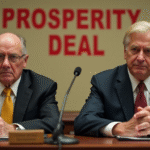Economic Growth in the United States Advances in Second Quarter of 2025
According to official data released on Wednesday morning, the United States’ economic growth advanced in the second quarter of 2025. However, analysts cautioned about distortions due to businesses anticipating tariffs from President Donald Trump.
GDP Growth Surpasses Expectations
The U.S. GDP expanded at an annual rate of 3% between April and June, surpassing analysts’ predictions. This reversal comes after a 0.5% decline in the first quarter, as reported by the Department of Commerce.
Trump’s Response to GDP Growth
In response to the positive GDP growth, President Trump increased his rhetoric for a reduction in interest rates. He specifically addressed Jerome Powell, the Federal Reserve Chairman, stating, “It needs to come down now.”
The Federal Reserve will announce its decision on interest rates by the Committee of Policy Making later in the day.
Analysts participating in the Briefing.com survey anticipated a Q2 GDP growth rate of 2.5%, but the actual figure was higher.
Distortions in GDP Growth
While analysts expected the GDP to recover as imports decreased, they warned that this might not be sustainable. Market forecasts suggest that the impending tariff implementation could elevate inflation, potentially affecting consumer spending patterns.
“The real GDP increase in Q2 mainly reflects a decrease in imports, which are subtracted from the PIB calculation,” stated the Department of Commerce.
The rebound also reflected an increase in consumer spending, as per the report.
Economists like Kathy Bostjancic from Nationwide highlighted the distortions in Q2 growth due to trade flows and inventory. However, she cautioned that this acceleration is not sustainable.
Trump’s Tariff Policies
Since returning to the U.S. presidency, Trump has threatened and enforced multiple waves of tariffs.
- A 10% tariff on almost all U.S. trading partners
- Increased tariffs on steel, aluminum, and automobiles
- Separate measures against Canada and Mexico over illegal immigration and fentanyl trafficking
The Trump administration also had a dispute with China, imposing tariffs on each other up to double digits.
Washington and Beijing reached a temporary truce to de-escalate this conflict. Both parties agreed this week in Stockholm to extend this pause, though the final decision rests with Trump.
Economic Undercurrents
Gregory Daco, Chief Economist at EY, noted in a pre-GDP report statement that the U.S. economy continues to navigate a complex web of countercurrents, making it difficult to clearly interpret its underlying momentum.
“The U.S. economic activity is slowing even as inflationary pressures resurge,” Daco added. “Pressures induced by tariffs, political uncertainty, severe immigration restrictions, and high-interest rates are restraining job creation, business investment, and household consumption.”
Key Questions and Answers
- Q: What was the GDP growth rate for Q2 2025? A: The U.S. GDP expanded at an annual rate of 3% between April and June, surpassing analysts’ predictions.
- Q: How did President Trump react to the positive GDP growth? A: Trump increased his rhetoric for a reduction in interest rates, specifically addressing Jerome Powell, the Federal Reserve Chairman.
- Q: What are the potential impacts of the impending tariffs on inflation and consumer spending? A: Market forecasts suggest that the impending tariff implementation could elevate inflation, potentially affecting consumer spending patterns.
- Q: What are Trump’s tariff policies? A: Since returning to the U.S. presidency, Trump has enforced multiple waves of tariffs, including a 10% tariff on almost all U.S. trading partners and increased tariffs on steel, aluminum, and automobiles.
- Q: How have the U.S. and China addressed their trade conflict? A: Washington and Beijing reached a temporary truce to de-escalate their trade conflict, agreeing this week in Stockholm to prolong the pause.






